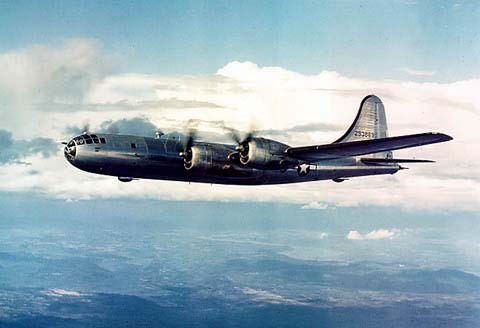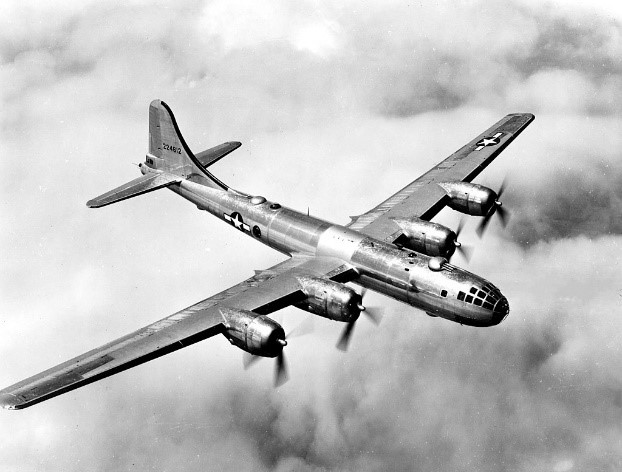Boeing B-29 Superfortress

The Boeing B-29 Superfortress was an American four-engine propeller-driven heavy bomber, designed by Boeing and flown primarily by the United States during World War II and the Korean War. Named in allusion to its predecessor, the Boeing B-17 Flying Fortress, the Superfortress was designed for high-altitude strategic bombing, but also excelled in low-altitude night incendiary bombing, and in dropping naval mines to blockade Japan. B-29s dropped the atomic bombs on Hiroshima and Nagasaki, the only aircraft ever to drop nuclear weapons in combat.

Enola Gay, a Silverplate version of the Boeing B-29 Superfortress landing after delivering
Little Boy over Hiroshima
B-29s started to arrive in India in early April 1944. The first B-29 flight to airfields in China (over the Himalayas, or “The Hump“) took place on 24 April 1944. The first B-29 combat mission was flown on 5 June 1944, with 77 out of 98 B-29s launched from India, bombing the railroad shops in Bangkok and elsewhere in Thailand. Five B-29s were lost during the mission, none to hostile fire. The history of its arrival in China is important. I recommend reading a quick review in Wikipedia here: Boeing B-29 Superfortress – Wikipedia
Generally speaking, in early April of 1944, the B-29 Superfortress bombers began to arrive in India and China as part of Operation Matterhorn in WWII. This operation conducted strategic bombing missions against the industrial and military targets of Japan. While based in India, the B-29s were located at airfields around Chengdu, China. These bases in China, particularly those around Chengdu, allowed the B-29s to reach Japanese home islands, those that were out of range from other Allied bases at the time.
With the Burma Road cut off by the Japanese, China became a critical location for placing operations despite its challenges. However, supplying these bases was incredibly difficult because at this time Japan controlled the Burma Road. All fuel, ammunition and other supplies had to be flown over “The Hump,” the Himalayas. Therefore, these bombing missions were extremely important for the Allies, and the B-29s played a crucial role in the Allied air campaign.

Superfortress 42-24812 Miss Su Su
During WWII, my cousin Joe Siciliano was stationed at Wendover Army Base in Utah. He stated the crew for the B-29 bombers that would carry the atomic bombs were there for training and were housed in a separate building than his unit. Wendover Army Airfield played a significant role during World War II as a training and preparation site for the 509th Composite Group, which carried out the atomic bomb missions. The B-29 bombers, including the Enola Gay, were stationed there for training and modifications. However, the actual loading of the atomic bombs for the missions to Hiroshima and Nagasaki took place at Tinian Island in the Pacific, not at Wendover.
While Wendover was crucial for testing and training, the final preparations and bomb assembly occurred closer to the mission targets. Joe was sent to India, China, and Burma from there and, although he had pilot training, he performed his duties as a dentist and army medic. I talk about him in my book, The WWII Chain Letter Gang.
